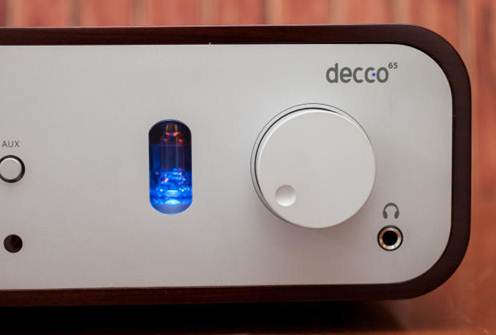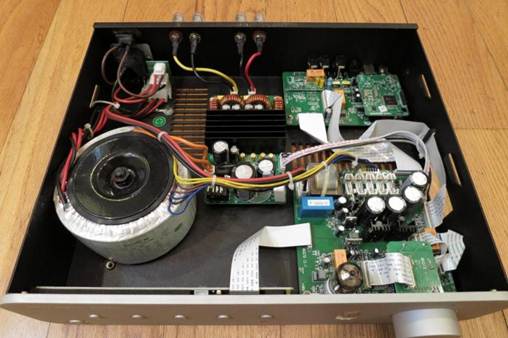Tonally, it’s not the most sumptuous; compared to a rival
Arc am FMJ A19, for example, you don’t get the sense that there’s a big, fat
bass and a warm, lustrous midland. But still it works well, giving a ‘clean’
rendition of the music that doesn’t impose, and lets you pick through all the
elements in the mix to make listening relaxed, but fun. This holds just as much
for the warm strains of The Byrd’s’ Chestnut Mare as it does for the somewhat harder
Micro Disney classic; the Peachtree signposts the differences in recording
quality very clearly, but doesn’t get too analytical. Pushed hard with the
volume control rammed against the end stop, this little amp begins to show
signs of strain, but short of using it as a disco amp you’re unlikely to run
into trouble if you use sensible speakers.

This holds just as
much for the warm strains of The Byrd’s’ Chestnut Mare as it does for the
somewhat harder Micro Disney classic; the Peachtree signposts the differences
in recording quality very clearly, but doesn’t get too analytical.
One of the main attractions of the decco65 is the digital
input functionality, not least because relatively few other amplifiers have
this feature – even if the ranks are now growing. So continuing with the Byrd’s
track, I hook up the Audio lab 8200 via a coaxial input, effectively using it
as a digital transport. It’s fair to say that the company hasn’t skimped on the
internal DAC’s quality; the sound changes to a slightly more direct, detailed
sort of rendition, albeit not quite as spacious and tonally rich as the
excellent Audio lab. But there is definitely more pace and clarity, which is no
small feat considering the talents of the Audio lab’s DAC stage, which I’d just
been listening to. So the Peachtree’s internal DAC is good enough for
audiophile use and is certainly not a gimmick, unlike a good number of other
amplifiers with this functionality. Ramping the digital quality up to 24/96, I
plug my MacBook Pro into the decco65 and summon up my high-quality Adriana
music playing application. The sound on Kate Bush’s Snowflake is suitably rich
and sonorous, dripping with the sparkling harmonics of that beautifully
recorded piano. The Peachtree pushes the stereo image very wide out into the
room, and is deep too; the effect is highly immersive, and really conveys the
emotion of the song. Feed it a good hi-res source, and this amplifier sings!

Fundamentally the
decco65 has a clean and fairly neutral sort of sound
Of course, the decco65 has been designed with one eye firmly
on convenience and domestic acceptability, so you wouldn’t expect it to
completely wipe the floor with its (mostly far more ungainly) price rivals,
which have much less of a preoccupation with style and sleekness. In absolute
terms, the amp is a little cool tonally, and doesn’t quite catch the powerful,
exuberant rhythms of punchy dance music such as Visioneers’ Come Play in the
Milky Night. Nor does its soundstage stretch quite as deep as it might, the
decco65 preferring to keep things pretty close to the plane of the
loudspeakers. But it’s still very listenable nonetheless and the same goes for
the excellent headphone output – it makes my Philips Fidelio X1 headphones
sound quite superb.
Conclusion
Here we have a fine sounding machine that provides easily
accessed, one-box functionality. It takes a digital signal from wherever,
converts it to analogue and amplifies it to a high standard, with the minimum
of fuss, space and hassle. It has plenty of power for most people’s listening
rooms and loudspeakers, and gives a pleasantly enjoyable sort of sound with no
nastiest. Importantly, it also looks like someone has actually designed it,
rather than just scooped it off the lab bench into a black metal box. If you’re
looking for an amiable, one-box amplifier and DAC then, this is well worth
trying out. It’s a nice package that makes music easy to access and fun to
play.

It’s a nice
package that makes music easy to access and fun to play.
How it compares
If it’s a lifestyle system you’re after, Aram’s lovely Solo
Mini ($957.30) is a good choice. It doesn’t have the plethora of digital inputs
that the Peachtree has, but it has lots of analogue line INS and a built-in CD
player and FM/DAB radio. All sources sound superb at the price and design,
build and ergonomics are quite brilliant. If you want like-for-like features
Audio lab’s Q-DAC/M-PWR ($1435.95) mini separates system gives a range of
digital inputs and hi-res USB, but it’s fiddler to use. It is a clear winner
for sound with a very tight, powerful and musical performance. But the
Peachtree wins hands down when it comes to pure convenience.
Our verdict
·
Sound quality: 4/5
·
Value for money: 4.5/5
·
Build quality: 4.5/5
·
Features: 4.5/5
·
Like: Smooth sound; fine build and ergonomics; nice packaging
·
Dislike: Not quite a match for the best separates, sonically
·
We say: High quality, fuss-free music listening – what’s not to
like?
·
Overall: 4.5/5
|
Technical
specs
·
Product: Peachtree Audio decco65
·
Origin: US/China
·
Type: Integrated amplifier/DAC
·
Weight: 12kg
·
Dimensions (W x H x D): 377 x 111 x 292mm
·
Features: ESS Sabre 9023 DAC, 24/192 max. resolution; 1x
coaxial, 1x optical, 1x USB, 1x line input; Headphone output; Switchable 6N1P
triode tube buffer
·
Distributor: Anthem AV Solutions Ltd
|